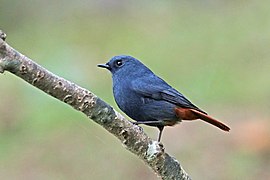| Plumbeous water redstart | |
|---|---|

| |
| Male in Doi Inthanon National Park, Thailand | |

| |
| Female in Plover Cove Country Park, Hong Kong | |
| Conservation status | |
 Least Concern (IUCN 3.1) | |
| Scientific classification | |
| Domain: | Eukaryota |
| Kingdom: | Animalia |
| Phylum: | Chordata |
| Class: | Aves |
| Order: | Passeriformes |
| Family: | Muscicapidae |
| Genus: | Phoenicurus |
| Species: | P. fuliginosus |
| Binomial name | |
| Phoenicurus fuliginosus Vigors, 1831 | |
| Synonyms | |
| |
The plumbeous water redstart (Phoenicurus fuliginosus) is a passerine bird in the Old World flycatcher family Muscicapidae. It is found in South Asia, Southeast Asia and China. Males are slate blue in colour, while females are grey. The bird's common name refers to its colour which resembles lead. They tend to live near fast-moving streams and rivers.
Taxonomy
The plumbeous water redstart belongs to the order Passeriformes and the family Muscicapidae. It was previously placed in the genus Rhyacornis but was moved to Phoenicurus based on the results of a molecular phylogenetic study published in 2010. The species consists of two recognized subspecies – Phoenicurus fuliginosus fuliginosus and Phoenicurus fuliginosus affinis. The former was described by Nicholas Aylward Vigors in 1831, while the latter was described by William Robert Ogilvie-Grant in 1906 and is found in Taiwan. In China, the female and first-year male redstarts appear more brown at the top, leading to the possibility of classifying them as a separate race tenuirostris.
Description
The plumbeous water redstart is typically 14 centimetres (5.5 in) long in total, with an average weight of 22 grams (0.78 oz) for males and 18.8 grams (0.66 oz) for females. The male birds are slate blue in colour with a tail that is rusty red. On the other hand, female birds are pale grey and feature a white rump.
Habitat
The bird is found in Afghanistan, Bangladesh, Bhutan, China, India, Laos, Myanmar, Nepal, Pakistan, Taiwan, Thailand, and Vietnam. Their preferred habitats are streams, nullahs and rivers with boulders that are shaded, as well as vegetation near riverbanks. Streams with higher populations of insects such as mayflies appear to be preferred.
They are typically found at relatively high elevations, with the ones living in the Himalayas seen between 2,000 metres (6,600 ft) and 4,100 metres (13,500 ft). However, they tend to descend to lower altitudes during the winter.
The plumbeous water redstart has been placed on the Least Concern category of the IUCN Red List, as the population has remained stable throughout the last ten years. The size of its distribution range is over 5,100,000 square kilometres (2,000,000 sq mi).
Behavior
The plumbeous water redstart is very protective of its habitat and will be extremely confrontational to any trespasser on its territory. In order to catch flies in rivers, it flies vertically until it is at least 20 feet (6.1 m) above the water, before gliding down in a spiral back to the same place.
Gallery
-
 male, Godawari, Lalitpur, Nepal
male, Godawari, Lalitpur, Nepal
-
 female, showing tail flick
female, showing tail flick
-
Male, Chaffi, Nainital, Uttarakhand
- male calling
References
- BirdLife International (2016). "Phoenicurus fuliginosus". IUCN Red List of Threatened Species. 2016: e.T22710092A94233528. doi:10.2305/IUCN.UK.2016-3.RLTS.T22710092A94233528.en. Retrieved 12 November 2021.
- Sangster, G.; Alström, P.; Forsmark, E.; Olsson, U. (2010). "Multi-locus phylogenetic analysis of Old World chats and flycatchers reveals extensive paraphyly at family, subfamily and genus level (Aves: Muscicapidae)". Molecular Phylogenetics and Evolution. 57 (1): 380–392. Bibcode:2010MolPE..57..380S. doi:10.1016/j.ympev.2010.07.008. PMID 20656044.
- Gill, Frank; Donsker, David (eds.). "Chats, Old World flycatchers". World Bird List Version 6.2. International Ornithologists' Union. Retrieved 20 May 2016.
- ^ "Plumbeous Water-redstart (Rhyacornis fuliginosa)". Handbook of the Birds of the World. Internet Bird Collection. 2003. Retrieved December 3, 2013.
- ^ Bezruchka, Stephen; Lyons, Alonzo (2011). Trekking Nepal: A Traveler's Guide. The Mountaineers Books. p. 291. ISBN 9781594854101. Retrieved December 3, 2013.
- Dunning, John B. Jr. (December 5, 2007). CRC Handbook of Avian Body Masses (Second ed.). CRC Press. p. 397. ISBN 9781420064452. Retrieved December 3, 2013.
- ^ Lawrence, Walter Roper (1895). The Valley of Kashmir. Asian Educational Services. p. 150. ISBN 9788120616301. Retrieved December 3, 2013.
- ^ Herklots, Geoffrey Alton Craig (1936). The Hong Kong Naturalist, Volumes 7–8. Newspaper Enterprise Limited. p. 150. Retrieved December 3, 2013.
- ^ Sibley, Charles Gald (1990). Distribution and Taxonomy of Birds of the World. Yale University Press. p. 538. ISBN 9780300049695. Retrieved December 3, 2013.
- MacKinnon, John Ramsay (June 8, 2000). A Field Guide to the Birds of China. Oxford University Press. p. 10. ISBN 9780198549406. Retrieved December 3, 2013.
plumbeous water redstart.
- ^ Ward, Francis Kingdon (1990). Himalayan Enchantment: An Anthology. Serindia Publications, Inc. pp. 173. ISBN 9780906026229. Retrieved December 3, 2013.
plumbeous water redstart.
- Dudgeon, David; Corlett, Richard (July 1, 1994). Hills and Streams: An Ecology of Hong Kong. Hong Kong University Press. p. 140. ISBN 9789622093577. Retrieved December 3, 2013.
- Manel, Stéphanie; Dias, Jean-Marie; Ormerod, Steve J. (August 17, 1999). "Comparing discriminant analysis, neural networks and logistic regression for predicting species distributions: a case study with a Himalayan river bird". Ecological Modelling. 120 (2–3): 337–347. Bibcode:1999EcMod.120..337M. doi:10.1016/S0304-3800(99)00113-1. (registration required)
- Negi, Sharad Singh (January 1, 1992). Himalayan Wildlife, Habitat and Conservation. Indus Publishing. p. 108. ISBN 9788185182681. Retrieved December 3, 2013.
- "Plumbeous Water-redstart (Rhyacornis fuliginosa)". BirdLife International. 2013. Retrieved December 3, 2013.
- Brazil, Mark (January 14, 2009). Birds of East Asia. A&C Black. p. 422. ISBN 9780713670400. Retrieved December 3, 2013.
External links
- Plumbeous water-redstart videos and photos on the Internet Bird Collection
- Oriental Bird Images: plumbeous water redstart Selected images
- Xeno-canto: plumbeous water redstart Sound recordings
| Taxon identifiers | |
|---|---|
| Phoenicurus fuliginosus | |